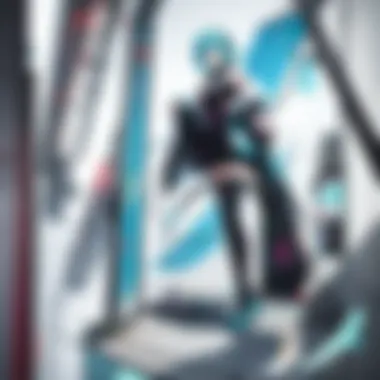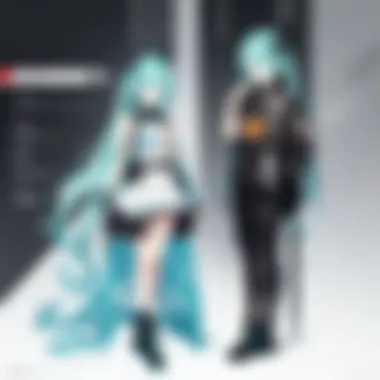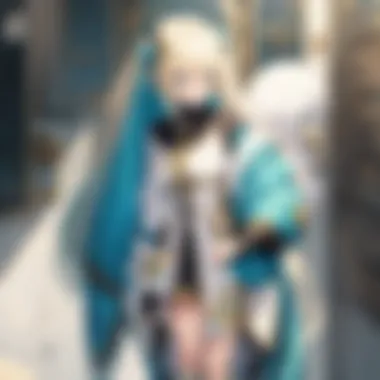The Aesthetic Appeal of Vocaloid Posters Unveiled


Intro
Vocaloid posters hold a unique place in the landscape of anime and music culture. These artworks serve as both a celebration and reflection of a vibrant community that thrives on creativity, fandom, and the shared appreciation for digital music. This article will explore various facets of Vocaloid posters, dissecting their aesthetic appeal, intricate styles, and the deep-rooted significance they have acquired over the years.
The Evolution of Vocaloid Artwork
Understanding the aesthetic appeal of Vocaloid posters requires an examination of their evolution. Initially launched in 2004, the Vocaloid program featured voices like Hatsune Miku, giving rise to an entirely new genre of music and digital art. Using software, creators began to produce visuals that captured the essence of the characters, resulting in an impressive portfolio of posters reflecting the growth of this art form.
Over the years, distinctive styles have emerged within the community. The limits have been pushed by artists using both traditional sketching techniques and digital software for graphic design. The integral use of color, softness of lines, and even the contrast in aesthetics all influence viewer interpretations and emotional responses.
As one may discover, these artworks are often characterized by:
- Vibrant colors that evoke energy and movement.
- Dynamic poses, showcasing the characters in ways that align with their musical styles.
- Complex backgrounds that host thematic elements designed to augment the mood.
Aesthetic Significance and Themes
The themes represented by Vocaloid posters vary widely, representing an array of artistic expressions. These posters frequently evoke themes such as love, heartbreak, and adventure. An iconic example is the portrayal of Hatsune Miku in concert settings, portraying the connection she has with her fans.
Scenes often ignite nostalgia, stirring feelings that resonate universally. Consequently, these pieces serve not just as art, but as emotional emblems for fans.
Posts as Cultural Artifacts
In larger terms, these Vocaloid posters can be seen as cultural artifacts. They contextualize how the community interprets digital and anime culture in contemporary reality. Each piece gives insight into shifting perceptions within fandom, identity, and art.
Researchers and enthusiasts have drawn connections between Vocaloid poster art and social movements. Vibrant graphics often incorporate intricate details that reflect social phenomena, increasing their relevance within the defended contexts. These pieces play a training role leveraging creativity in an age marked by digital creation.
The Community Behind the Posters
There is a profound unity in the communities that rally around Vocaloid artwork. Artists often achieve recognition and acclaim through platforms that center around fan contributions, discussions, and sharing artwork across social media. Posters become focal points for celebrations, showcases of talent, or tribute pieces memorializing the shared affinity for these characters and their music.
Many online platforms, such as Reddit and DeviantArt, serve as sanctuary spaces from which fans discover and dispay creation. Within these circles, individuals share experiences, breeding an ever-evolving array of discussions about skills and preferences around the various styles and themes found in Vocaloid posters.
A vibrant community unites talents, confronting obstacles such as artistic suppression, providing invaluable support in honing their craft while reinforcing a collective identity.
Culmination
Intro to Vocaloid
Vocaloid represents a unique intersection of music, technology, and art within contemporary culture. Understanding this phenomenon is essential for appreciating its aesthetic output, particularly in the realm of posters. This section brings forward the fundamentals of Vocaloid, setting a foundation for further exploration into posters as visual symbols of this musical landscape.
Definition and Origins of Vocaloid
Vocaloid is a singing voice synthesis software created by Yamaha, initially released in 2004. The program allows users to synthesize singing by arranging words and melodies according to the pitch and timing they specify. Users can choose from various vocal libraries featuring digital singers characterized by unique vocal timbres. Among these, Hatsune Miku became a standout, emerging as not just a digital singer but a cultural icon that encompasses food at various levels influencing music creation, performance, and fan engagement.
From a production standpoint, Vocaloids combine innovations in sound synthesis, manipulation of compositional tools, and the interface designed to engage users, balancing complex technical requirements with user accessibility.
The evolution of Vocaloid, particularly through collaborations with both independent and mainstream artists, fuels global interest and spurs engagement across cultures. This software enables compositions that evoke high emotion and polarization, expressing unique experiences grounded in their creators' interpretations. By establishing a musical landscape of synthesized voices, timeline experiences in the Virtual sphere resonate through a rich tapestry of.output.
Cultural Impact of Vocaloid
The cultural significance of Vocaloid is multifaceted. Initially, it started as niche software but has progressively grown into a beacon of creative output for diverse communities. It contributed to the development of a new music genre often labeled as “Vocaloid music,” which fosters creativity amongst producers, fans, and visual artists alike.
Several elements characterize the cultural impact of Vocaloid:


- Collaborative Creation: One prominent aspect of Vocaloid culture is collaboration among users. Composers often mix various genres, building remarkable interdisciplinary bridges.
- Fandom and Community Development: The community surrounding Vocaloid is incredibly active. Platforms such as Reddit serve as hubs for fan art sharing and discussions. Spaces like this invite creators to showcase poster art interpretations while engaging discussions about vocalists and their impact through artistry.
- Cultural Reflection: Through its characters and songs, Vocaloid art provides a mirror reflecting societal trends, personal experiences, and emerging youth culture across the globe.
Cumulatively, Vocaloid functions as more than just auditory software; it acts as a digital canvas for expressing one's ideas while creating intricate visual artistry, as admired within community-enhanced environments. The significant results underscore Vocaloid's vital influence on contemporary music, suggesting future cultural continuities that merit exploration in forthcoming sections.
Understanding Vocaloid Posters
Vocaloid posters serve as more than just decorative pieces; they encapsulate the essence of a vibrant community and a dynamic art form. Exploring their significance involves looking at their physical characteristics and the deeper meanings behind individual works. Posts that display these characters often showcase unique sociology among fans, while also spotlighting multifaceted artistic expressions.
What Constitutes a Vocaloid Poster?
A Vocaloid poster can be defined by several core elements that distinguish it in the broader realm of art. Firstly, it must prominently feature a Vocaloid character. This character is primarily derived from music software that enables users to synthesize singing. Popular names like Hatsune Miku, Kagamine Rin, and Megurine Luka frequently dominate these visual representations.
Beyond character representation, the design, color usage, and typography all denoted individual artists' styles. Posters often integrate vibrant colors, intricate details, and themed backgrounds that relate directly to the character’s digital persona or song narrative. A poster that showcases these aspects accurately reflects not only the character but also the songs the character has performed, intertwining visual art with music.
Lastly, mediums play a vital role, with artworks frequently created using digital tools or traditional methods. The choice affects the final aesthetic significantly, allowing fansa to invest personally in their collections. Thus, understanding what forms a Vocaloid poster also means analyzing the diverse expressions that fans often showcase.
Common Themes in Vocaloid Poster Art
Diving deeper into the artistic world behind Vocaloid posters, there are themes that emerge effortlessly across the board.
- Performance and Music: Many posters mirror the musical pursuits of Vocaloids, featuring elements that symbolize energy and vibrancy found in concerts.
- Emotional Expressions: The portrayal of characters in diverse emotional states establishes connection points with the audience, drawing on a wide spectrum of emotions.
- Fashion and Aesthetic Styles: Each character has a distinctive visual style, spanning kawaii, gothic, or futuristic themes. These styles attract certain audiences and create recognition around what the character inherently presents.
- Fantasy and Escape: Artwork often inhabits enchanting worlds, encouraging a sense of escapism alongside individual encounters within whatever narrative unfolds.
The intersection of music and visual art in Vocaloid posters creates a multi-dimensional cultural tapestry that entices dedicated enthusiasts.
Through these recurring themes, fans can explore not only their favorite characters but also connect to broader cultural narratives inherent in their text. They enrich the understanding of Vocaloids beyond just music into the multifaceted realm of artistry and creativity.
Understanding the significance of Vocaloid posters serves as an entry point to deeper discussions about cultural significance and community engagement. Knowledge of what constitutes these posters and the common themes illusion of deeper meanings sets the stage for honing into their true aesthetic appeal.
Artistic Styles and Techniques
Artistic styles and techniques form the backbone of vocaloid posters, contributing not only to their visual appeal but also to the viewer's emotional response. The act of creating an engaging poster requires skill, knowledge, and understanding of various artistic elements. Each style carries its own set of nuances, while different techniques can enhance the imagery and message being conveyed. Exploring these aspects is essential for appreciating the depth and richness of vocaloid artwork.
Digital Art vs.
Traditional Mediums
The debate between digital art and traditional mediums is a significant aspect within vocaloid poster creation. Digital art offers flexibility and efficiency, allowing artists to experiment and modify elements without the permanence associated with traditional mediums. This immediacy appeals to artists who often rely on software like Adobe Photoshop or Clip Studio Paint.
On the other hand, working with traditional mediums like watercolor or markers brings a unique authenticity. Artists focusing on watercolor create softer edges and textures that can produce highly emotive outcomes. The skill set required in traditional art forms different from digital, often leading to a reverberation of stylistic choices that resonate with fans and collectors.
Ultimately, both forms enrich voices in vocaloid poster creation, appealing to varied tastes within the fandom. Many artists now fuse both methods, creating a hybrid style that merges the best attributes of each medium, allowing greater expression.
Color Palettes and Their Symbolism
Color palettes significantly shape the mood and aesthetic of vocaloid posters. Artists utilize specific colors to evoke feelings and convey themes. For example, bright colors like yellow often represent joy, while darker hues might indicate introspection or melancholy.
A comprehensive understanding of color basics emphasizes the role that each hue plays in artwork:
- Red: Passion or emotion
- Blue: Calmness or sadness
- Green: Growth and life
- Yellow: Cheerfulness and energy
Artists carefully choose these colors not just for beauty but for emotional resonance, establishing a connection that might be instantaneous or deeply layered. This consideration highlights the psychological aspects of color and its crucial role in displaying vocaloid characters’ narratives within a poster.
Character Design in Vocaloid Posters


Character design is a central pillar in determining the captivating nature of vocaloid posters. Each character possesses unique attributes and traits that manifest in their posture, color schemes, and overall design aesthetic. For instance, Hatsune Miku is often portrayed with her iconic turquoise hair and futuristic outfits that emphasize her digital origins.
The intricacies of these designs appeal to varying preferences in the fan community. Key aspects to consider include:
- Distinctive Features: Elements like hairstyles and clothing set characters apart.
- Personality Traits: Expressive facial designs convey their background stories or emotions, creating engagement with the audience.
- Accessories: These often reflect character roles within their narratives.
Effective character design intertwines with thematic storytelling, elevating visual representations and making the posters not just decorative items, but pieces of potent storytelling in their own rights.
'Vocaloids are not mere digital avatars; they embody a community's creativity and narrative expression.'
Engaging with vocaloid poster art thus delays traditional judgement by incorporating full spectrum artistic practices and ranging art forms. Whether the preference leans towards splashes of vibrant colors, refined digital techniques, or intricate character design, the value of vocaloid posters lies in their artistic integrity and community connection.
Popular Vocaloid Characters in Poster Art
Vocaloid posters are a significant aspect of fan culture and visual representation in the digital art sphere. The popularity of specific characters plays a crucial role in shaping these artworks. Characters such as Hatsune Miku, Kagamine Rin, Len, and Megurine Luka represent unique aesthetics that resonate with fans globally. This subsection highlights how these characters influence the visual style and emotional response elicited by the posters, illustrating their importance both artistically and culturally.
Hatsune Miku: The Icon
Hatsune Miku stands as the quintessential Vocaloid character. Her visual representation in posters reflect a harmonious blend of playful and futuristic design. Designed initially for the software, she has transcended her digital origins to become a cultural phenomenon. Artwork featuring Miku often utilizes bright color palettes and dynamic poses to capture her energy and charm.
Fans are naturally drawn to this character not just for her distinctive appearance, but also for her contributions to music. Miku’s role as a乙者, along with her infectious enthusiasm, has cultivated a unique following. Her image resonates deeply within the community as an embodiment of creativity and freedom of expression. The posters serve not only as art but also represent connections to music, performances, and fandom events.
Kagamine Rin and Len: Duality in Art
The appeal of Kagamine Rin and Len lies in their mirrored design and suggested narratives of duality. Rin, characterized by her youthful energy, and Len, presenting a more laid-back demeanor, they mesh well in artworks that echo themes of collaboration and balance. In many instances, they are depicted engaging in activities that highlight their bond, emphasizing unity among contrasting personalities.
Art showcasing Rin and Len often plays with complementary color schemes, using cooler hues to convey a sense of intimacy while juxtaposing the characters. These visuals tap into their relationship dynamics. Posters can invoke feelings of nostalgia and reflection on personal experiences. Understanding their portrayal fosters deeper appreciation for the artistry involved.|
Megurine Luka: Aesthetic Versatility
Megurine Luka is known for her distinct styling that contrasts both Hatsune Miku's fuller aesthetic and the duality of Kagamine counterparts. She presents a more mature image, which attracts fans who favor elegance intertwined with complexity. Visuals featuring Luka frequently utilize a wide range of styles, from sleek and polished to dynamic and whimsical. This versatility enhances her role in various multimedia presentations, including music, games, and art based on her image.
Luka's posters often evoke sophistication combined with emotional depth. Artists use detailed backgrounds and intricate color combinations to enhance her presence. It represents broader notions of femininity within Vocaloid culture. By depicting her in varied scenarios, the artwork illustrates the flexibility and layered character traits that megurine Luka embodies.
In summary, the characterization and individual aesthetic of these three leading figures amplify their standing in the Vocaloid community. The richness of their representations in poster art encapsulates diverse aspects of enjoyment and interaction among fans, revealing not just personal taste, but collective identity.
Vocaloid Poster Collections and Merchandising
Vocaloid poster collections represent more than just an assembly of artistic pieces; they embody a vibrant intersection of art and community. These collections act as keepsakes for enthusiasts, capturing the evolution of Vocaloid culture. The act of collecting has practical benefits, such as providing access to limited editions and exclusive merchandise. Collectors often engage with others in community spaces, sharing their finds and displaying their passion. This aspect fosters a sense of belonging and camaraderie.
Fan Collections and Community Sharing
The significance of fan collections lies in their power to unite individuals. Fans actively pursue items that resonate with personal favorites, such as particular characters or specific artwork styles. These collections eventually become a public exhibition of identity.
Fans often utilize platforms like Reddit and Facebook to showcase their collections. They exchange tips on where to find rare items and sometimes even barter among themselves. Photos posted online strengthen the community by stimulating discussions, showcasing creativity, and causing admiration.
The practice of sharing extends further to group gatherings like anime conventions or meetups. Many fans can exhibit their collections in person. This not only enhances appreciation for Vocaloid artwork but also allows fans to connect on various levels. In this context, the collection enters into a dialog with others: encouraging different interpretations of poster aesthetics, and establishing synchrony within the climbing Vocaloid culture.
Commercial Merchandising and Market Trends
The market for Vocaloid posters possesses unique dynamics due to its blending of personalization with commercial viability. Vendors often align their offerings with fandom enthusiasm, leading to remarkable variations in styles and themes. Traditional anime merchandise meets new artists promoting reimagined visuals.
In recent years, more companies have recognized Vocaloid's potential, resulting in increased merchandise production. Major retailers and niche markets now offer a robust selection of products. This creates non-linear revenue possibilities for businesses, especially with limited edition items, making them highly sought after. Demands or mentions of characters like Hatsune Miku and Megurine Luka dominate much of the market activity.


Vocaloid poster projects often extend to collaborations with popular artists, resulting in limited-time prints or exclusive releases. The entrepreneurial initiative creates excitement in the community while driving interest in various artistic interpretations. Trackable trends, from online auctions to launch events, reflect an adaptive market, responding to consumer interest swiftly. As new technology emerges, concepts of merchandising will continue evolving to sustain the vibrant pulse of this unique culture.
Cultural Significance of Vocaloid Posters
Vocaloid posters serve as much more than mere decorative items; they function as essential aspects of cultural heritage in the anime and music community. The intricate artwork captivates viewers and reflects a myriad of emotional expressions and narratives, allowing audiences to connect on a personal level. In a world dominated by digital art, these posters symbolize not just personal tastes but also belonging to a community of like-minded individuals who share an appreciation for this unique aesthetic.
Furthermore, Vocaloid posters can act as historical artifacts, marking the evolution of musical technology and the art style that evolves alongside it. Observing shifts in both character designs and thematic execution can often indicate broader trends in cultural narratives across genres and social contexts. This insightful view lets one understand how creativity is heavily influenced by trends and technologies over time.
Posters as a Form of Expression
Vocaloid posters embody a powerful vehicle of expression. Artists utilize various pop culture references, emotions, and societal elements that resonate with fans. The designs often highlight well-known characters like Hatsune Miku, inviting creativity from fans who may interpret these symbols in unique ways. For individuals, displaying vocaloid posters provides a canvas through which their admiration can be visualized and shared publicly.
Additionally, many fans often enter into the space of artistic expression through fan art concerning these characters. Utilizing social media platforms, like reddit.com, enthusiasts share their interpretations, build community, and inspire one another. This form of communal participation fosters intimate discussions regarding art styles, musical elements, and character appeal within the Vocaloid universe.
Vocaloid Posters in Global Context
Globally, vocaloid posters have gained significant traction, transcending geographical boundaries. The enthusiasm around Vocaloid culture reached diverse audiences that originate from various backgrounds, each adding their cultural flavors into the mix. As a result, posters reflect not only shared fan sentiments but also unique regional influences, leading to greater complexity in visual art.
In countries outside Japan, artists may introduce traditional motifs or local themes by remixing existing Vocaloid characters. For instance, while Japanese designs often focus on futuristic elements, Western interpretations might amplify certain characteristics related to storytelling or mythological concepts. This blend illustrates the global resonation of Vocaloid fame and incorporates richly diverse cultural marks into the art form, positioning vocaloid posters as conduits for global understanding.
The Future of Vocaloid Poster Art
The future of Vocaloid poster art is a topic that carries significant weight within the scope of this article. As technology and culture constantly evolve, the realm of vocaloid art adopts new trends and capabilities. There are several intricate elements to consider, including artist techniques, audience engagement, and the impact of emerging technologies on media consumption.
Both refreshingly innovative and dynamic, the landscape of Vocaloid poster art reflects shifts in society. As diverse creators rise within the community, they introduce fresh styles and experiments that reshape traditional concepts of art. This progresses a cultural dialogue that allows audiences to connect profoundly with their favorite Vocaloid characters.
Emerging Trends in Vocaloid Art
Vocaloid poster art continuously adapts to new influences, with several emerging trends indicating the direction this art will take. One notable trend is the integration of animated elements into graphic design. More artists are producing posters that utilize motion graphics, making the posters more interactive.
The use of 3D rendering techniques is also rising in popularity. Artists achieve deeper character realism and immersive environments, attracting viewers who enjoy heightened audio-visual experiences. These trends indicate that audiences increasingly seek modernity and interactivity in the art forms they engage with.
Additionally, artworks are now common themes of collaboration between professional artists and hobbyists for mutual learning and development. Online platforms have enabled this confluence, forming vibrant communities. Artists can share their work using social media platforms like Facebook, enticing widespread audience feedback.
Values centered upon diversity and inclusivity are shaping artistic expressions too, leading to a broader representation of characters and ideas within the Vocaloid framework. It is not just about nostalgia but fostering a nuanced understanding of character depth.
Impact of Technology on Vocaloid Art
Technology has an undeniable influence on the future of Vocaloid art. Software improvements in graphic design tools allow for greater artistic freedom and creativity. Programs like Adobe Photoshop and Blender enable precise designs and diverse styles, empowering artists to visualize their ideas vividly.
Another vital aspect is the use of artificial intelligence in art creation. With AI sorted to emulate various artistic styles, such developments could pave new avenues for poster art while raising questions about originality and authorship.
Furthermore, platforms for sharing artwork, such as Reddit and DeviantArt, allow instantaneous feedback, fostering a collaborative and evolving environment. Artists can adapt quickly to audience preferences, bonding creators closely with their community.
Technology is not only changing how art is created but also how it is consumed.
Closure
In examining the aesthetic appeal of Vocaloid posters, it becomes clear that these artworks are much more than mere decorations. They encapsulate a rich cultural significance and serve various purposes within the broader anime and music landscape.
Vocaloid posters act as vivid reflections of fandom. Fans appreciate the artistry behind these posters. They showcase characters in unique styles, each promoting different emotions or themes. This graphic representation becomes a bridge between fans and the music or digital personas they admire.
Key points of significance included in this article are:
- Cultural Relevance: The posters reflect trends, beliefs, and the evolving dynamics within the Vocaloid community.
- Visual Artistry: They represent distinct artistic techniques and mediums, enabling expression despite cultural barriers. Fans interact with these works in personal and public settings.
- Community Connection: Vocaloid posters foster a sense of belonging among enthusiasts. They can be shared online and showcased in collectibles, linking people worldwide.
Furthermore, artists, whether amateur or seasoned, strive to convey their interpretations through vocaloid art. A vocational artist’s skills become part of the larger tapestry of available Vocaloid artwork, demonstrating not only individuality but also the converging influence of technology.
An essential consideration raised in this article is how instantly recognizable characters, such as Hatsune Miku, Kagamine Rin and Len, and Megurine Luka, contribute to their respective poster narratives. Merchandising trends reflect the growing acceptance and commercialization of these artistic forms. Authentication in obtaining and exhibiting Vaporwave-inspired pieces has grown indispensable. Especially among serious collectors, the loyalty they exhibit towards specific artists or character designs enriches the community that surrounds them.







